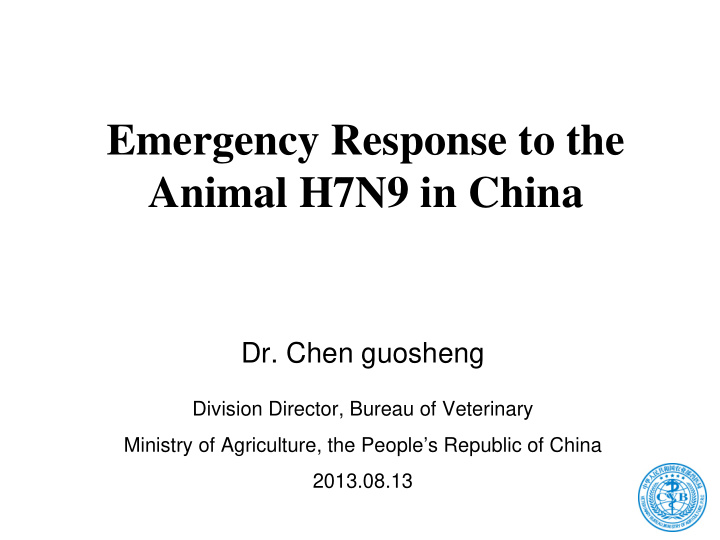



Emergency Response to the Animal H7N9 in China Dr. Chen guosheng Division Director, Bureau of Veterinary Ministry of Agriculture, the People’s Republic of China 2013.08.13
Outline � Situation on Prevention and Control of H7N9 � Control measures from the veterinary sector � Next Step
Situation on Prevention & Control of H7N9 The Current Status: � The first human case was confirmed on March 31 The first positive animal sample was found in a LBM on April 4 � The emergency response status has returned to normal control status in animal population � The human cases are in a state of scattered distribution So far, 134 human cases were confirmed, with 43 dead and 4 cured.
Control measures from the veterinary sector in China Enhance cross-sector collaboration � A joint working mechanism for H7N9 prevention and control was established at the central level among 16 departments, and also at local government level. � Rapidly launch the joint prevention and control mechanism � MOA issued an announcement to temporarily uplift the H7N9 AIV into the list of Class A Animal Diseases. (Guideline)
Control measures from the veterinary sector in China Comprehensive emergency surveillance 1. Core surveillance area (R) 2. Key surveillance area (Y) 3. Ordinary surveillance area (W)
Control measures from the veterinary sector in China Comprehensive emergency surveillance
Control measures from the veterinary sector in China Comprehensive emergency surveillance
Control measures from the veterinary sector in China Comprehensive emergency surveillance From May 23 to July 30, totally 325,220 samples were tested, including serological samples(171373 ) and pathological samples(153,847)
Control measures from the veterinary sector in China Comprehensive emergency surveillance
Control measures from the veterinary sector in China Comprehensive emergency surveillance
Control measures from the veterinary sector in China Comprehensive emergency surveillance
Control measures from the veterinary sector in China Comprehensive emergency surveillance Other surveillance results institute samples positive AQSIQ 62539 0 Hongkong 22590 0 NHFPC 1874 0
Control measures from the veterinary sector in China Comprehensive emergency surveillance � H7N9 virus has been only detected in chicken, duck and pigeon. � Limited extent of infection. H7N9 positive samples were found from 18 LBM of 7,264 markets that have been sampled (0.25%). � Samples have been collected from 30,382 poultry farms in 31 provinces, but no confirmed positive results from pathogen samples.
Response level and disposal � The MOA’s Announcement (No. 1919) � Animal H7N9 Emergency Response Guideline. • Movement control for suspicious flocks • Cull infected groups; clean, disinfect and close the market
Systematic epidemiological investigation Epidemiological investigation � Yangtze Delta Area Emergency Investigation � Market-Chain Analysis
Systematic epidemiological investigation No association between human H7N9 cases and the structure of poultry production
Systematic epidemiological investigation LBMs play a significant role in the propagation and spread of H7N9 AIV
Systematic epidemiological investigation The transportations of live birds play an important role in the spread of H7N9 AIV
Close live bird markets temporarily Date of Province City LBMs Closure 2013/4/6 Shanghai Municipality Nanjiang, Shuqian, Suzhou, Wuxi, Zhenjiang, 2013/4/6 Jiangsu Province Yangzhou, Suzhou, Yancheng Huzhou, Hangzhou, Wenzhou, Jiaxing, Zhejiang Province 2013/4/15 Shaoxing Henan Province Kaifeng, Zhoukou, Zhengzhou 2013/4/14 Shandong Province Zhaozhuang 2013/4/23 Fujian Province Longyan, Fuzhou 2013/4/29 Jiangxi Province Nanchang 2013/4/26
Close live bird markets temporarily Epidemiological curve of human cases in Shanghai and Zhejiang
Strengthening supervision on movement of live birds For provinces with human cases and H7N9 virus detected from animal and environment samples, following supervision measures were enforced: � The inter-province movement of commercial live birds were temporally prohibited. � Without animal health certificate proved by H7N9 AI testing, breeding poultry or day- old poultry were not allowed to be transported to other places. � Encourage the practice of slaughtering live birds within the local abattoirs, and the sale of frozen fresh poultry meat on the market. � Promote scientific-based and safe consumption.
Cooperation and communication � Timely information release � Timely information release � Joint investigation with FAO � Joint investigation with FAO- - ECTAD China Office ECTAD China Office � OIE experts � OIE experts’ ’ field visit on field visit on H7N9 in China H7N9 in China � Sharing the experience with � Sharing the experience with relevant international Org. and relevant international Org. and countries. countries. Tech.& Policy Discussion on the Prev. Tech.& Policy Discussion on the Prev. and Cont. of H7N9 in Asia and Cont. of H7N9 in Asia (24- -25 June 2013, Bangkok Thailand ) 25 June 2013, Bangkok Thailand ) (24
Next Step � The study on H7N9 strains and their pathogenic character is still ongoing. � Implementing the plan for animal H7N9 surveillance the revised scheme . All level vet. labs are continuously conducting surveillance and early warning tasks. � Re-opening LBMs based on standardized management � Scientific prevention and control as important as stabilizing the poultry industry. (FAO-MOA, China)
Thank you Thank you for for your attention! your attention!
Recommend
More recommend